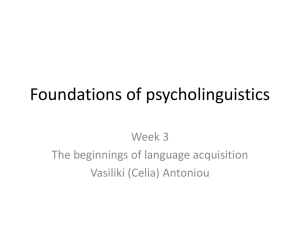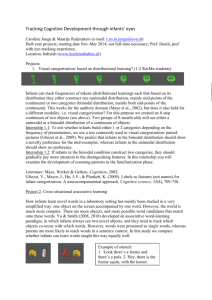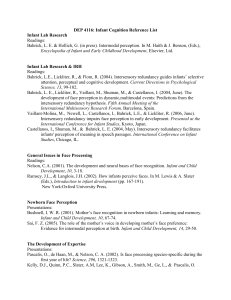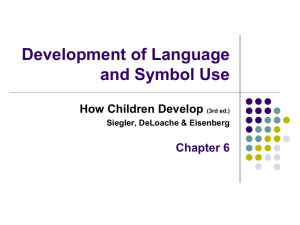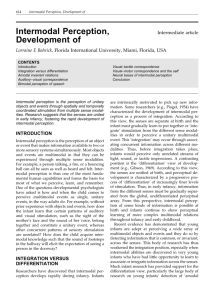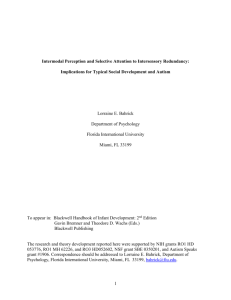Speech and Communication - Infant Development Laboratory
advertisement
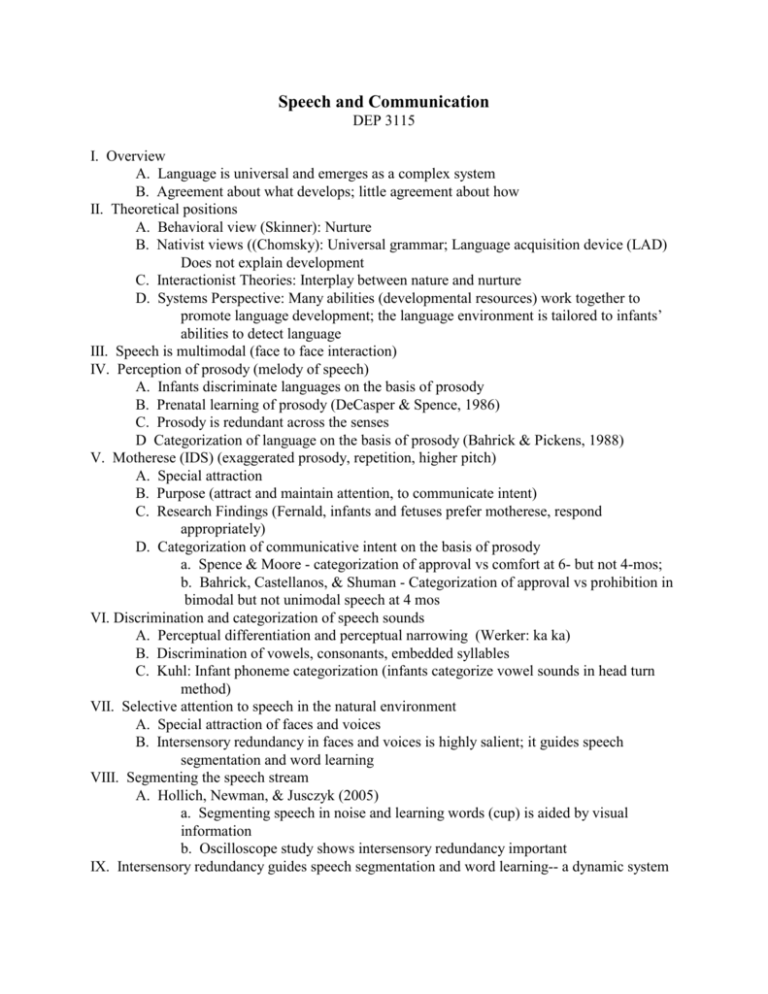
Speech and Communication DEP 3115 I. Overview A. Language is universal and emerges as a complex system B. Agreement about what develops; little agreement about how II. Theoretical positions A. Behavioral view (Skinner): Nurture B. Nativist views ((Chomsky): Universal grammar; Language acquisition device (LAD) Does not explain development C. Interactionist Theories: Interplay between nature and nurture D. Systems Perspective: Many abilities (developmental resources) work together to promote language development; the language environment is tailored to infants’ abilities to detect language III. Speech is multimodal (face to face interaction) IV. Perception of prosody (melody of speech) A. Infants discriminate languages on the basis of prosody B. Prenatal learning of prosody (DeCasper & Spence, 1986) C. Prosody is redundant across the senses D Categorization of language on the basis of prosody (Bahrick & Pickens, 1988) V. Motherese (IDS) (exaggerated prosody, repetition, higher pitch) A. Special attraction B. Purpose (attract and maintain attention, to communicate intent) C. Research Findings (Fernald, infants and fetuses prefer motherese, respond appropriately) D. Categorization of communicative intent on the basis of prosody a. Spence & Moore - categorization of approval vs comfort at 6- but not 4-mos; b. Bahrick, Castellanos, & Shuman - Categorization of approval vs prohibition in bimodal but not unimodal speech at 4 mos VI. Discrimination and categorization of speech sounds A. Perceptual differentiation and perceptual narrowing (Werker: ka ka) B. Discrimination of vowels, consonants, embedded syllables C. Kuhl: Infant phoneme categorization (infants categorize vowel sounds in head turn method) VII. Selective attention to speech in the natural environment A. Special attraction of faces and voices B. Intersensory redundancy in faces and voices is highly salient; it guides speech segmentation and word learning VIII. Segmenting the speech stream A. Hollich, Newman, & Jusczyk (2005) a. Segmenting speech in noise and learning words (cup) is aided by visual information b. Oscilloscope study shows intersensory redundancy important IX. Intersensory redundancy guides speech segmentation and word learning-- a dynamic system A. Gogate, Bahrick, & Watson (2000) - the importance of audiovisual synchrony for word learning a. Synchrony between naming and showing objects highlights word-referent relations (multimodal motherese) b. A dynamic system- mothers decrease their use of synchrony as infant reliance on synchrony decreases X. The development of babbling- a dynamic system A. Goldstein, King, & West (2003) a. Mothers shape infant babbling to become more mature by contingent social responsiveness b. Contingent condition improved but yoked control condition did not c. Infants can learn nonnative speech patterns this way (VCV Yoruba) d. Birds also show social shaping of song learning in similar system e. Example of a mother-infant system for speech learning XI. Statistical learning A. Infants learn transitional probabilities that sounds will occur together B. Saffran, Aslin, & Newport (1996) statistical learning of artificial speech -3 syllables C. Infants perceive serial order of sounds and do not need innate language mechanisms XII. The structure of early communication - protoconversation A. Condon & Sander (1974) observe turn taking in newborns B. Infants detect social contingencies and are distressed if they are interrupted (Trevarthan- recorded play back of interaction; Still face paradigm) XIII. Sharing attention and emotional states A. Vitality contours (feeling flow patterns, temporal and intensity patterns of speech; direction and shape of energy; multimodal) B. Affect attunement (matching vitality contours) C. Joint visual attention (JVA; sharing attention and communicating about something “out there”) D. Intersubjectivity (a sense of shared experience; coordinating perspective with another) E. Social referencing (using adult’s emotional expression to regulate infant behavior toward a novel object)

